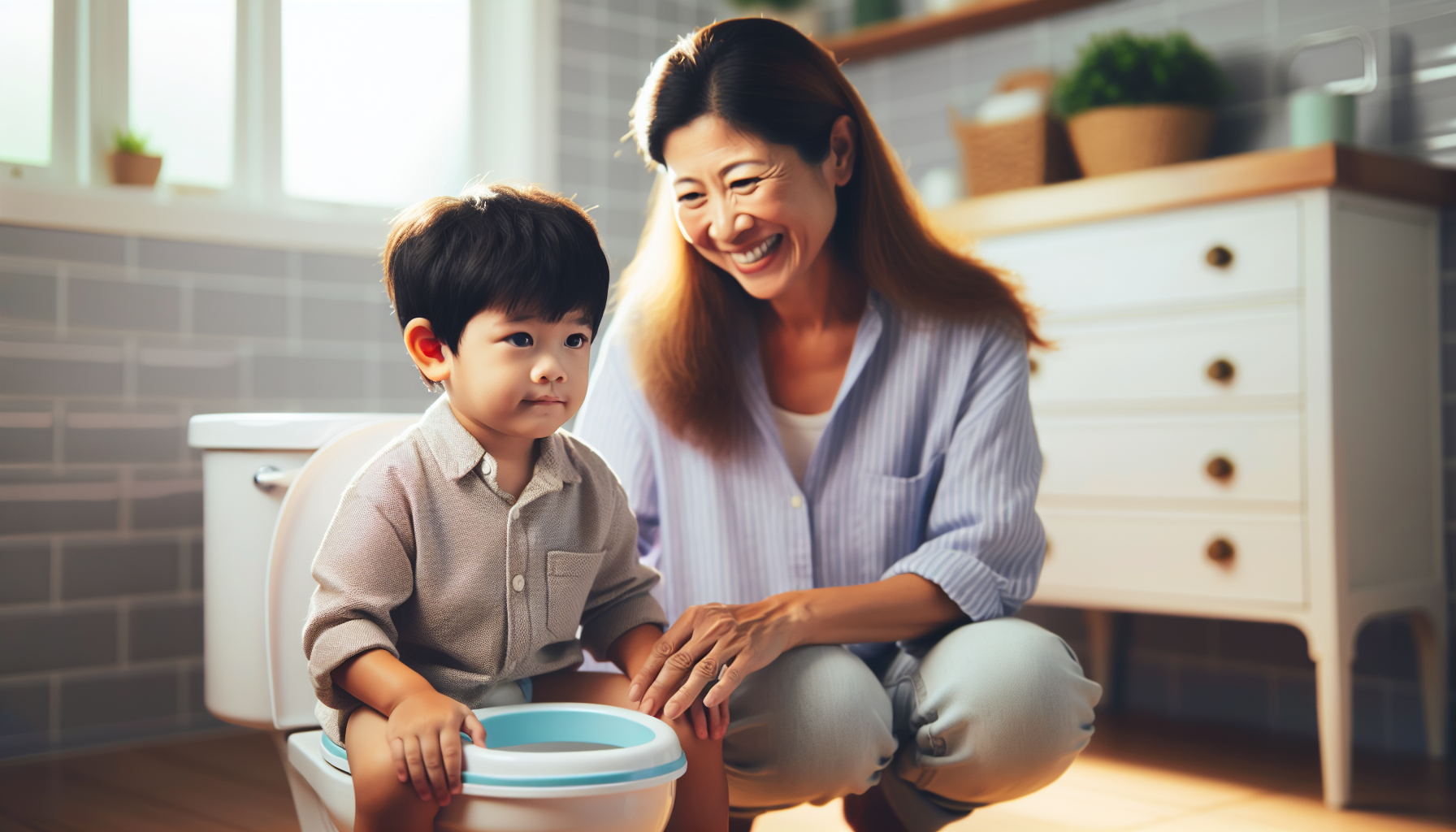Potty Training an Autistic Child: The Basics
Potty training can be a challenging process for any child, but it can be particularly complex when it comes to potty training an autistic child. Understanding autism and the specific challenges associated with toilet training is essential for developing effective strategies to support these children.

Understanding Autism and Toilet Training
Autism is a developmental disorder that affects communication, social interaction, and behavior. When it comes to toilet training, children with autism may face additional obstacles due to communication delays and sensory issues that can cause resistance to using the toilet. It’s important to recognize that each child with autism is unique, with their own strengths, challenges, and individualized learning styles.
Challenges in Potty Training Autistic Children
Potty training an autistic child can be a more prolonged and intricate process compared to children without autism. According to Golden Care Therapy, the average age at which children with autism become potty trained is 3.3 years, compared to 2.5 years for children with other developmental disabilities and 2.3 years for neurotypical children.
Some common challenges in potty training autistic children include:
- Communication difficulties: Autistic children may have trouble expressing their needs or understanding verbal instructions, making it important to find alternative ways to communicate during toilet training.
- Sensory issues: Many autistic children have sensory sensitivities that can affect their comfort and willingness to engage in toileting activities. Sensory challenges may include aversions to certain textures, sounds, or bathroom environments.
- Resistance to change: Autistic children often rely on routines and may struggle with transitions. Introducing a new routine like potty training can be met with resistance or anxiety.
- Delayed readiness signs: Autistic children generally show the same signs of readiness for toilet training as typically developing children, but these signs might appear when they are older, and the training might take longer.
To effectively potty train an autistic child, it’s crucial to approach the process with patience, flexibility, and a tailored approach that takes into account their unique needs and learning style. By understanding these basics, parents and caregivers can begin to explore effective strategies for potty training autistic children.
Effective Strategies for Potty Training
Potty training an autistic child requires an individualized approach that takes into consideration their unique challenges and needs. By understanding the three phases of successful potty training and implementing positive reinforcement techniques, parents and caregivers can help their autistic child navigate this important milestone.
Three Phases of Successful Potty Training
According to Golden Care Therapy, effective potty training of an autistic child involves three phases: planning, setup, and implementation.
- Planning Phase: During this phase, parents and caregivers gather information about their child’s specific needs and preferences. It’s important to consider any sensory issues or communication delays that might affect the child’s ability to use the toilet. Developing a structured plan and setting realistic expectations is key to laying the foundation for successful potty training.
- Setup Phase: In this phase, parents create a supportive environment for potty training. This includes purchasing appropriate equipment, such as a child-sized toilet seat or a step stool, to make the process more accessible and comfortable for the child. It’s also important to establish a consistent routine and introduce visual supports, such as picture cards or schedules, to help the child understand the steps involved in using the toilet.
- Implementation Phase: The implementation phase is when parents and caregivers begin actively working with the child to develop toileting skills. This involves consistent and patient guidance, using positive reinforcement techniques, and providing clear and simple instructions. It’s important to monitor the child’s progress, adjust strategies as needed, and celebrate small achievements along the way.
Positive Reinforcement Techniques
Positive reinforcement is a powerful tool in potty training autistic children. It involves providing rewards and praise to motivate and encourage the child to use the toilet. Immediate and consistent rewards are essential to reinforce desired behaviors.
According to Golden Care Therapy, rewards can range from verbal praise and hugs to small treats or engaging in a favorite activity. The key is to find what motivates the child and use it as a positive reinforcement. Gradually fading out the rewards over time while maintaining praise can help the child develop intrinsic motivation and independence in using the toilet.
Parents and caregivers should also be mindful of the individual preferences and sensory needs of the child. Some children may prefer non-tangible rewards, such as verbal praise or a high-five, while others may respond better to tangible rewards, such as stickers or small toys. Adjusting the rewards to match the child’s preferences can enhance the effectiveness of positive reinforcement.
By implementing the three phases of successful potty training and utilizing positive reinforcement techniques, parents and caregivers can help their autistic child develop important toileting skills. Each child is unique, so it’s important to tailor the strategies to the individual needs and abilities of the child. With patience, consistency, and support, potty training can become a positive and successful experience for both the child and their caregivers.
Visual Aids and Support Tools
When it comes to potty training an autistic child, utilizing visual aids and support tools can be highly effective. Many children with autism are visual learners, and incorporating visual cues and prompts can help motivate and guide them through the potty training process.
Utilizing Visual Cues and Prompts
Visual cues and prompts, such as picture cards, charts, or toilet training books, can play a crucial role in supporting an autistic child during potty training. These visual aids help children understand and follow the steps involved in using the toilet. By visually representing each step, children can better comprehend the process and feel more confident in their abilities.
Creating a visual schedule or chart that outlines the sequence of events during toilet training can be particularly beneficial. This schedule can include pictures or symbols representing each step, such as entering the bathroom, sitting on the toilet, wiping, and washing hands. Consistency in using visual aids by everyone involved in the training process is essential to reinforce the routine.
Benefits of Social Stories
Social stories are another valuable tool for assisting autistic children in managing challenging situations, including toilet training. These stories use simple language and visuals to explain what is expected of the child in different scenarios, such as using the toilet in unfamiliar places. Social stories are often created with the help of professionals like speech pathologists or teachers, ensuring they are tailored to the child’s specific needs and understanding.
By incorporating social stories into the potty training process, parents and caregivers can help children develop a better understanding of the steps involved in using the toilet. These stories can provide a clear and predictable structure, reducing anxiety and confusion. Reading social stories regularly can also reinforce positive behaviors and help children feel more comfortable and prepared during toilet training.
Remember, each autistic child is unique, and it may be necessary to experiment with different visual aids and support tools to find what works best for your child. The key is to provide clear and consistent visual cues and prompts that cater to the child’s individual learning style and sensory needs. Together with patience, understanding, and a supportive environment, visual aids and support tools can significantly contribute to successful potty training for autistic children.
Professional Resources and Guidance
When it comes to potty training an autistic child, seeking professional resources and guidance can be incredibly helpful for both parents and caregivers. These resources provide valuable information, support, and strategies tailored to the unique needs of autistic children.
Support from Autism Parenting Magazine
Autism Parenting Magazine offers a wealth of resources specifically designed for parents with autistic children. They provide a free resource guide that covers a wide range of topics, including autism statistics, diagnosis, behavior management, access to autism services, and more. This comprehensive overview of autism resources for parents is a valuable tool in navigating the challenges that come with raising an autistic child.
In addition to their general resources, Autism Parenting Magazine also offers a guide specifically focused on autism potty training. This guide provides information on the challenges parents may encounter, how to prepare the child, steps in the potty training process, and additional tips to ensure a successful experience.
Workshops and Groups for Parents
CHEO (Children’s Hospital of Eastern Ontario) offers a variety of in-person and virtual workshops and groups for parents and caregivers of children with autism. These workshops cover various topics, including potty training. For instance, in-person group sessions on daily living skills, including potty training, consist of three consecutive two-hour sessions and are recommended for children ages 9-12.
CHEO also provides virtual education sessions on specific areas like daily routines, toilet training, and returning to the school environment. These sessions offer valuable insights and strategies for parents and caregivers. Additionally, CHEO offers virtual workshops on toileting, which include implementing a toileting plan to address urine and bowel movements, as well as tips and strategies to overcome potential barriers.
By utilizing the resources and guidance provided by Autism Parenting Magazine and participating in workshops and groups offered by organizations like CHEO, parents of autistic children can gain valuable knowledge, support, and practical strategies to facilitate the potty training process. These resources are designed to empower parents and caregivers, ensuring they have the tools they need to help their child achieve success in potty training.
Tailoring Strategies for Autistic Children
When it comes to potty training autistic children, it’s essential to recognize that each child is unique and may require a tailored approach. An individualized approach takes into account the specific needs and challenges of the child to create a plan that maximizes their success. Here are two key strategies for tailoring potty training for autistic children: an individualized approach to toilet training and adapting to the child’s sensory needs.
Individualized Approach to Toilet Training
An individualized approach to toilet training involves recognizing that there is no one-size-fits-all method. It’s important to consider the child’s developmental level, communication abilities, and learning style. Breaking the process down into smaller steps and gradually building upon them can help the child feel more comfortable and confident.
Establishing a routine is crucial for autistic children during potty training. Consistency and routine provide a sense of predictability and structure, which can aid in their comfort and learning process. By consistently following the same schedule each day, the child can become familiar with the routine and begin to understand and anticipate the steps involved in using the toilet.
Adapting to the Child’s Sensory Needs
Autistic children often have sensory processing differences that can impact their toilet training experience. Sensory issues may cause resistance to certain aspects of the process, such as sitting on the toilet seat, using toilet paper, or flushing. Adapting to the child’s sensory needs can help create a more comfortable and supportive environment.
Consider making adjustments to the physical environment to accommodate the child’s sensory preferences. For example, using a cushioned or padded toilet seat can provide a more comfortable seating experience. Introducing gradual exposure to different steps, such as starting with weeing in the garden, then progressing to a bucket, and eventually using the toilet, can help the child adjust to new sensations and reduce anxiety [2].
Using visual supports, such as picture cards, social stories, or video modeling, can also be beneficial for autistic children. Many children with autism are visual learners, and these visual cues and prompts can help motivate and guide them through the potty training process. Visual supports provide a clear and visual representation of the steps involved, helping the child understand and follow the routine.
By implementing an individualized approach and adapting to the child’s sensory needs, parents and caregivers can create a supportive and effective potty training experience for autistic children. It’s important to remain patient, provide positive reinforcement, and celebrate each milestone achieved along the way. With time, consistency, and understanding, potty training can become a successful and empowering journey for both the child and their caregivers.
Overcoming Common Hurdles
Potty training an autistic child can be a unique journey with its own set of challenges. It’s important to approach setbacks and obstacles with patience and understanding. In this section, we will explore two common hurdles that parents may encounter during the potty training process and strategies to overcome them.
Dealing with Accidents Positively
Accidents are a natural part of the potty training process for autistic children, and it’s crucial to approach them with a positive mindset. Instead of viewing accidents as failures, they should be seen as cues for learning and opportunities for growth. Punishment or negative reinforcement can be counterproductive and hinder progress.
When accidents occur, it’s essential to remain calm and supportive. Avoid expressing frustration or disappointment, as this can create anxiety and hinder the child’s willingness to continue with the training. Instead, focus on providing positive reinforcement by acknowledging the child’s efforts and offering encouragement. This helps build their confidence and motivates them to keep trying.
Maintaining a consistent routine is also vital in dealing with accidents. Establishing a regular toileting schedule helps the child become familiar with the process and reduces the likelihood of accidents. By creating a predictable routine, the child feels more comfortable and can better anticipate their bathroom needs.
Seeking Medical Advice and Support
If your child is facing significant difficulties or experiencing prolonged challenges during the potty training process, seeking medical advice and support can be beneficial. Consulting with healthcare professionals, such as pediatricians, occupational therapists, or psychologists, can provide valuable insights and tailored strategies to address specific issues.
Behavioral problems or constipation are among the setbacks that autistic children may encounter during toilet training. Professional guidance can help identify the underlying causes and provide effective interventions to overcome these hurdles. Occupational therapists can assist with sensory-related challenges, while psychologists can offer behavioral strategies and emotional support.
Remember, every child is unique, and their potty training journey may require individualized approaches. Seeking professional input ensures that you receive expert advice tailored to your child’s specific needs. With the right guidance and support, you can navigate these hurdles and help your child achieve success in their potty training journey.
By approaching accidents positively and seeking medical advice and support when needed, parents can overcome common hurdles encountered during the potty training process for autistic children. Remember to maintain a patient and understanding attitude throughout the journey, as every child progresses at their own pace. With consistency, encouragement, and appropriate strategies, you can support your child in developing essential toileting skills.
References
- https://www.goldencaretherapy.com/potty-training-a-child-with-autism/
- https://raisingchildren.net.au/autism/health-wellbeing/toileting-hygiene/toilet-training-autism
- https://www.autismparentingmagazine.com/autism-resources-parents/
- https://www.autismparentingmagazine.com/autism-potty-training/
- https://www.cheo.on.ca/en/clinics-services-programs/family-foundational-services.aspx
- https://allypediatric.com/blog/potty-training-your-child-with-autism/

 We've just released an article!
Check out our blog!
We've just released an article!
Check out our blog!



